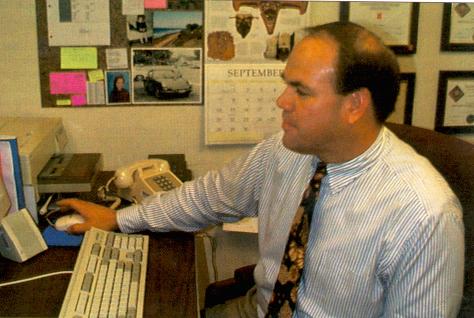Government Computer News
November 10 1997 - Technology Report
PTO net suffers growing pains
Despite problems, PowerHub will handle switching on new agency network
By William Jackson
GCN Staff
Midway through setting up an asynchronous transfer mode network to link 6,000 users in 16 Arlington, Va., buildings, the Patent
and Trademark Office has run into bugs with its Fore Systems Inc. hardware.
If completed as planned in November, the PTO Integrated Network will have more than 20 ASX 1000 l0-gigabit/sec backbone
switches from the Pittsburgh company, plus 150 PowerHub 7000 closet switches.
"This will be one of the biggest PowerHub installations in the country," said PTO computer engineer Wes Clark, who oversees
the network.
A recent experience with a bad batch of PowerHub cards had PTO officials rethinking the strategy, though it seems unlikely they
will change vendors.
"We can't make a decision whether to dump the PowerHub or not," Clark said. "It seems a little late in the process to do that.
We're going to have to make the PowerHubs work in this environment. It's been a long process, and we're not entirely through it."

There have been other problems updating code in the ASX 1000 switches already installed, he said.
Fore Systems representatives attributed the problems to a batch of bad cards that escaped a screening process because of a mix-up
in serial numbers.
What's the deal?
"It's not a big deal," said Stephen J. White, manager of Fore's technical product marketing. "The issues have been identified, and
they are all correctable." Spare cards are available on site to replace the bad ones, he said.
PTO offcials, however, were unhappy that they were not notified earlier of the bad production run.
"We had this sort of conversation about incremental disclosure about a year ago," Clark said.
The integrated network will replace a pair of Fiber Distributed Data Interface rings that support separate networks for office
automation and the Automated Patent System. The ATM network will bring switched Ethernet to the desktop PCs of thousands
of patent and trademark examiners who access millions of online images.
The new network will more than triple the 3 megabits/sec delivered to PCs by the old router-based network.
FDDI "served us well, but it cannot meet the bandwidth requirements of the near future," Clark said. "Our customers are demanding new capabilities."
The demands arise because the number of patent applications received each year is expected to grow from 212,000 in 1997 to
258,000 in 2002, and Congress wants PTO to maintain or reduce the average 18-month turnaround time.
Over the same period, the number of trademark applications filed each year is expected to go from 218,000 to 351,000.
The increased workload requires hiring more examiners, who analyze more than 200 years' worth of patent and trademark documents. This work is speeding up under the Automated Patent System, which replaces boxes of paper documents with digital images
on Unix servers. The automated system now has 27 terabytes online in a server farm.
APS in the past has run on three FDDI rings connected by routers with hubs to deliver shared Ethernet to examiners' PCs. In an
early step toward integration, the network in 1993 joined via a 100-megabit/sec link to the single-ring FDDI office automation
network.
The PTO Integrated Network eventually will provide a common transport facility, making all PTO applications accessible from
all PCs.
ATM was the choice for the network because it can best serve future needs, Clark said. PTO will pilot a PC video system next
year, and further plans call for a telephone switch to blend data and voice networks on the campus LAN.
"We're just now starting to investigate that," Clark said. "ATM seems suitable for that kind of multimedia. Also, we're trying
to emulate what private industry is doing," and most businesses with high-bandwidth requirements are going to ATM, he said.
The design of the integrated network brought its own challenges. PTO has offices in 16 buildings spread over a mile along Jefferson
Davis Highway in the Crystal City area of Arlington, and people relocate frequently from office to office.
"We try to accommodate them with network drops," Clark said.
"But we don't have a procedure for removing them," he said.
The network constantly changes, so administrators have no clear picture of what is and what is not on it. "We had problems trying
to design to a moving target," Clark said.
A second problem was the aging fiber-optic infrastructure of the Crystal City complex. The original cabling, some installed a
dozen years ago, has deteriorated in places and made circuits unstable. In many buildings, more cable is being pulled.
PTO also wants redundant Sonet OC-12 lines between buildings. As Navy offices move out of Crystal City, PTO is using their
cable where possible to establish redundant links.
The switches have been another problem. No other product came as close to meeting PTO's needs for a robust closet switch as
Fore's Powerhub.
When deployment began earlier this year, however, the 7000 was a "bleeding-edge box." one engineer said.
"We had some teething problems" with the switches, White said.
Fore and systems integrator Signal Corp. of Fairfax, Va., have worked hard to eliminate bugs and give the PowerHub 7000 the
reliability PTO needs. "Signal has been doing yeoman service on this," Clark said.
"PTO is an extremely demanding customer," White said.
White acknowledged PTO has to be a stickler for network reliability, because any downtime idles highly paid attorneys and
examiners. "It's hell to pay," he said.
"Our cash flow depends on our network," Clark said. The outcome should be a robust network that will fill PTO's needs into
the next century.
"It really would take a lot to bring this network down," White said.